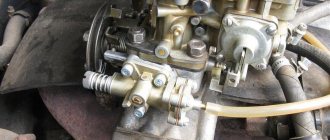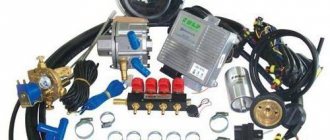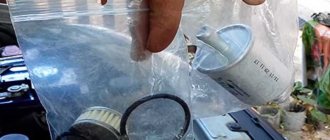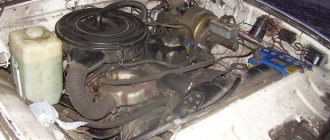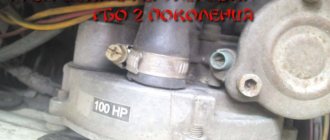Features of the operation of 4th generation gas equipment
The equipment allows for combined power supply of the engine with gasoline and gas. Switching from one power mode to another can be done from the cabin manually, as well as automatically. The small control panel contains an LED gas level indicator and a fuel switch. The usual location of the control panel is under the steering column on the left near the headlight adjustment control.
The gas indicator contains four green LEDs and one red, located in one row. When one green LED lights up, it indicates the presence of 10 liters of gas. Usually this reserve is enough for 100-120 km. The red LED lights up to indicate the presence of emergency fuel remaining, which may be enough for 50-80 km. It warns you about the need to refill gas at a gas filling station.
A separate red LED, located in the upper corner of the remote control and operating in a flashing mode, signals that the engine is currently running on gasoline, but the system is preparing to switch to gas fuel. This happens every time the engine is started until it reaches normal temperature and warms up well.
Button for switching engine power mode and gas quantity indicators
Since the engine has both a gasoline and gas power supply system, such duplication doubles the reliability of its operation. In addition, the mileage on one refueling with gasoline and gas fuel increases significantly. This is beneficial on long trips through sparsely populated areas, where the network of gas stations is sparse and of poor quality. Also adding the ability to increase protection against car theft is an easily removed and installed switch, the removal of which blocks the supply of gasoline and gas to the injectors.
The 4th generation LPG is especially beneficial for car owners whose engines are equipped with an expensive fuel injection system with a catalyst for purifying exhaust gases. It not only provides significant savings on expensive high-octane AI-98 fuel, but also saves the life of the catalytic converter. This equipment is intended for vehicles that meet environmental requirements Euro-3 and higher. It has a pulsed gas-air mixture injection system, which operates under the control of a separate control unit interfaced with a microprocessor. The control unit processes microprocessor commands and generates control signals that open the electromagnetic gas injection injectors and block the gasoline mixture supply injectors.
The concentration of the supplied fuel mixture is controlled by a system of sensors that determine:
- gas pressure;
- reducer temperature;
- gas temperature.
If the supply gas pressure drops below a threshold value, the electronic unit automatically turns off the gas injectors and opens the gasoline injectors, switching the engine to gasoline power.
Programs for HBO
■ Program for the Digitronic system MAXI 2 (version 1) — — ZIP >> ■ Program Stag200Easy-0.3.0.6233 for STAG 200 GoFast — — ZIP >> ■ DIGITRONIC DGI 3D-S Power (ver. 11.1.0.3 from 08.09. 2015) — — ZIP >> ■ DIGITRONIC Maxi-2 / Maxi-2 TITAN (version 0.4.1.7001) — — ZIP >> ■ STAG 300 — AcGasSynchro (version 11.1.0.20 from 05.24.2015) — ZIP > > ■ CVT TAP-01 / TAP-02 (version 1.6.27 from 09/24/2012) - ZIP >> ■ OBD tester SXC 1011 (version 1.20 from 06/26/2015) - ZIP >> ■ AC AFR - analyzer exhaust gases (version 1.0.0) - ZIP >> ■ STAG TUNING (version 1.1.0.0) - ZIP >> ■ USB interface, drivers Windows XP, Vista, vin7,8,10 - ZIP >>
■ Updated (from 04/01/15) program for Dijitronic blocks AEB - - ZIP >> ■ Setup and adjustment program for Maxi 2 block (version 0.3.0.5921) - - ZIP >> ■ Setup and adjustment program for Maxi2 and Maxi2 blocks Titan (version 0.3.0.6679) — — ZIP >> ■ DIGITRONIC 11.1.0.1 program for Digitronic 3D-S Power and Maxi units of the 1st generation — — ZIP >> ■ DIGITRONIC iQ (GasPro version 0.18.34.7068 + Demo version from 17.10 .2015) — NEW — — ZIP >> ■ Software update for DIGITRONIC Maxi-2 / Maxi-2 TITAN units (version 0.5.2.7510) — — ZIP >> ■ DIGITRONIC MP-32 / MP-48 / MP-48 OBD / 2568 OBD / MP6C (version 6.2.1.0 from 05/25/2015) - ZIP >> ■ DIGITRONIC-AEB direct injection FSI (version 3.0.3.0 from 12/12/2014) - ZIP >> ■ Stag QBOX/Qnext/ QMAX/Diesel/DPI/variator TAP-03 (ver. 0.18.23.6959 dated September 15, 2015) — ZIP >>
Note: To download programs correctly, we recommend using the latest versions of browsers: Google Chrome, Yandex.Browser, Mozilla Firefox
Drivers
- Lecho MiniSec OBD TEST VERS ver 04/17/2009 and USB drivers.rar (3.41 MB) - PDF >>
- SEKWELL setup program and USB driver (1.4 MB) - PDF >>
Connection diagram for fuel rail pressure emulator (GM)
- Fuel pressure emulator FPE-GM Instructions (ver.1.1)( 0.8 Mb ) — — PDF >>
- FPE-GM wire colors (0.1 MB) - PDF >>
Changes and amendments to the “DIGITRONIC Software Version 11.1.0.1 for Digitronic 3D-S Power units and first generation Maxi units.”
- Configuration of the gas injection sequence in the “Installation of gas injectors” window.
- Correction of the algorithm (now there is no need to manually set values).
- Addition of the “Acceleration Correction” function, which prevents the engine from flooding with gas (particularly when using CNG fuel) during sudden acceleration of the load at low speeds.
- Adding protection against unwanted gas injection after the engine is stopped.
- Optimization of adjustments for temperature and pressure of injectors.
- Improved built-in adjustment based on gas temperature.
- Elimination of the dependence of the multiplier value on the gas temperature during auto-calibration.
- Adding gas level sensor: 43pp8-15 CNG.
- Adding sensor diagnostics: gas temperature, reducer temperature, gas pressure, vacuum pressure in the intake manifold (MAP)
- Adding an error report window that saves gas equipment operating parameters when a gas controller error occurs.
Among car enthusiasts and specialists, discussions often arise on the topic of optimal fuel consumption in the form of gasoline or gas. As practice shows, gas-cylinder equipment is more economical during operation. However, its installation requires capital investment. In the Russian Federation, Digitronic equipment is in demand. It is the Digitronic HBO that will be discussed in our article today.
Composition and operation scheme of 4th generation gas equipment
4th generation HBO scheme
HBO includes three components:
- Cylinder for refilling liquefied gas;
- Multivalve;
- Gas preparation, distribution and injection unit.
The multivalve is installed on the neck of the gas cylinder. It is designed to ensure filling of the cylinder and economical and safe consumption of gas while powering a running engine. It includes:
- 3 valves – inlet (filling), outlet (consumable) and emergency (high-speed);
- cylinder refill indicator;
- fuel intake pipe.
The high-speed valve ensures that the flow channel is closed in the event of a rapid gas leak when the connecting tube from the cylinder to the engine is broken or damaged.
The gas preparation and distribution system consists of:
- a single-stage reducer when using propane or a two-stage reducer for methane. The reducer ensures the transfer of fuel from liquid to gaseous state. A two-stage reducer also reduces gas pressure;
- nozzle ramp with jets;
- filter for gas purification.
The engine is designed to start on gasoline. Gas starting is an abnormal mode and is allowed if the gasoline system is faulty. However, it creates a large load on the gearbox diaphragm and significantly reduces its service life. When the engine warms up steadily to 20-300C, it automatically switches to gas power. When gas pressure drops to a threshold value, the engine automatically switches back to gasoline power. At the same time, a special sound signal is generated, warning the driver about the lack of gas.
The 4th generation gas system does not allow the appearance of various pops in the fuel intake channel, characteristic of poorly synchronized mechanical supply systems. Therefore, it can be safely mounted on engines with plastic manifolds and systems with adjustable gas mixture supply geometry. After installing the equipment, it is imperative to adjust the ignition timing, since the combustion time and octane number of the gas are large. It requires earlier ignition, i.e. greater advance angle.
Is it better to use methane or propane?
A 4th generation gas installation can consume both methane and propane-butane as fuel. Due to the type of gas used, the 4th generation HBOs differ in design from each other.
Since methane in cylinders is contained under high pressure, the cylinders must be appropriate.
At the outlet from the cylinder, a filter is included in the design to capture mechanical impurities in the gas.
Gas lines must withstand high pressure. The gas reducer of a car running on this gas has two sections, passing through which the gas pressure is reduced to the required level. Otherwise the design remains unchanged.
The disadvantage of using this type of gas is the large weight of the cylinders, which is not always acceptable for passenger cars.
In addition, there are significantly fewer methane gas stations. But this gas is cheaper, so its use is more relevant in commercial vehicles.
In installations designed to use propane-butane, since this gas is in a liquefied state, the cylinder is significantly smaller in size and weight.
The reducer for this gas has only one section. Gas is purified from impurities by a filter included in the design after the reducer.
Advantages of fourth generation gas equipment
The 4th generation HBO has a number of undoubted advantages compared to its older predecessors. These include:
- Maximum engine efficiency due to the accuracy of formation of the required gas mixture for each operating mode.
- Smooth operation of the power unit, complete absence of “pops” characteristic of early types of gas equipment.
- High degree of environmental friendliness of the engine, meeting Euro 3/4 requirements, due to complete and high-quality combustion of fuel. In this case, the actual reduction in engine power is no more than 2%.
- The versatility of the equipment allows it to be installed on almost all brands of modern cars due to software and hardware compatibility with the EOBD self-diagnosis system.
- Unified block connectors, eliminating equipment installation errors due to personnel inattention and reducing its labor intensity.
- High reliability of equipment operation and affordable price obtained through the use of modern production technologies.
Main problematic issues related to the operation of gas equipment
During the operation of a car with 4th generation gas equipment, a deterioration in its dynamic characteristics may be observed. The reasons for this phenomenon may be:
- malfunction of the gearbox or its incorrect setting, including the dispenser;
- filter clogging;
- reduced temperature of the gas-air mixture (typical for the winter period of operation);
- excessive enrichment of the mixture due to low gearbox temperature.
Something else useful for you:
If the car takes a long time to start, the reason for this may be:
Video: 4th generation LPG on Suzuki Grand Vitara new
- a malfunction of the gearbox diaphragm or its incorrect setting;
- defect of the flow solenoid valve (mechanical armature jamming or the presence of a short circuit of the turns);
- failure of the electronic unit, expressed in the absence of a permitting signal for gas supply or in the generation of an incorrect signal that does not correspond to the required amount of fuel;
- a malfunction of the starter, which “lowers” the battery voltage during startup, as a result of which the solenoid valves do not operate;
- wear of the piston and cylindrical surfaces of the engine, leading to a decrease in pressure in the cylindrical heads;
- if a vacuum reducer is used, then an additional reason for poor starting may be that insufficient vacuum is created in the inlet manifold due to the need for suction. In such cases, a separate electromagnetic pump can help out, providing forced fuel supply.
Maintenance of fourth generation gas equipment
1. Required to be performed weekly:
- external inspection of the system tightness, absence of gas leaks. A leak can be detected by the characteristic smell of an odorant and using a soap solution. Leakage can occur through cracks in the tubes, worn seals or loose tube clamps;
- removal of accumulated condensate in the gearbox through a special bottom plug. Untimely draining of condensate can lead to its coking and clogging of the drain hole, which subsequently, when condensate accumulates, leads to disruption of the normal operation of the evaporator reducer.
2. Required to be performed monthly: cleaning or replacing the filter. To do this, you need to disconnect the inlet tube from the filter and dismantle the filter. Clean or replace the filter element. There is a small magnet inside which should be replaced after cleaning the filter. 3. The gearbox should be disassembled and cleaned once every two years. In this case, care must be taken not to dent or tear the membrane. After cleaning and assembling the gearbox, be sure to check for leaks.
Car fuel systems differ in the principle of fuel supply to the engine. Since gas-cylinder equipment interacts specifically with the fuel system, it is also divided into types. Each type of gas equipment differs in components and equipment. For ease of understanding, it is customary in society to divide gas equipment into generations (1st, 2nd, 3rd, 4th generations).
OMVL produces equipment of all generations. True, cars running on 2nd and 3rd generation gas equipment are becoming fewer and fewer every year. Therefore, it is the fourth generation of HBO that is popular in Russia (simplified names: “GBO 4 generations” and “GBO 4”).
The principle of operation of 4th generation gas equipment is similar to the principle of operation of a gasoline fuel system. As with any injection system, fuel is supplied to the intake manifold through injectors under pressure. In a gasoline system, pressure is created by an electric fuel pump located in the gas tank. Gas fuel is initially stored in a cylinder under excess pressure, so the gas cylinder equipment kit uses a reducer that reduces the pressure to the required level before supplying it to the engine.
The process of reducing pressure is accompanied by the absorption of a significant amount of heat, therefore, as in earlier systems, the gas reducer in HBO 4 is connected to the engine cooling system.
The HBO 4 system provides constant quality control of the fuel mixture entering the engine, therefore, cases of failure of the engine valve-piston group are minimized and, importantly, dynamic characteristics close to those of gasoline are maintained. And the principle of phased gas supply to the area close to the intake valve prevents the possibility of ignition of the mixture and the appearance of “pops” in the intake manifold.
How to connect all elements of the gas system?
Each 4th generation LPG kit must contain a connection diagram for an injection car; the system is installed according to it. For different manufacturers it may differ slightly (for example, the electrical circuit), but the general installation principle for all types of gas equipment is the same.
The installation process begins from the engine compartment. To begin with, it is advisable to protect the paintwork of the car by covering the lining and fenders with rag material. Remove the battery terminals.
Correct installation of gas injectors
In order to install HBO injectors, it is necessary to dismantle the intake manifold. You can, of course, not remove it, but then you are likely to encounter a number of difficulties:
- it is inconvenient to drill the manifold;
- violation of the correct/synchronous positioning of the nozzle nozzles (inserts);
- metal shavings getting into the engine cylinders.
If a plastic manifold is not so critical, then duralumin/aluminum, especially cast iron, is unacceptable to drill on the engine. This can lead to damage to the CPG (cylinder-piston group) or valves and their seats. The uniformity of gas supply depends on the correct location of the fittings.
So, after dismantling the manifold, as close as possible to the intake valves and the holes of the gasoline injectors, at the same angle (approximately 45˚), towards the center of the intake passage (along the air flow), we drill holes with a diameter of 4.8 mm. Also, to connect the vacuum, we make a hole in the manifold receiver, closer to the throttle valve.
Here it is important not to damage the walls of the wells of the standard injectors; also, mark and mark the drilling points in advance with a marker. Consider the possibility of reassembly so that the fittings do not interfere with the fastening of the manifold to the cylinder head.
Then, use an M6 tap to cut the thread and screw in each fitting using a hexagon or an appropriate wrench. Do not use excessive force; the brass inserts are easy to break off.
Some nozzles have tapered threads, so additional sealing is not worthwhile. But in some cases (for example, a hole has become loose) or for greater confidence, you can use a special sealing adhesive/thread locker.
We install the manifold in the reverse order, not forgetting to install a new gasket. Next, we screw the ramp with the injectors tightly to the engine, using a strip and dampers. We put on gas hoses/sleeves from the injectors to the fittings, securing them with clamps. There are four rules to consider here:
- the length of the hose should not be more than 15-20cm (the shorter the better);
- hoses must be cut to the same/equal length;
- do not exceed the nozzle angles recommended by the manufacturer;
- It is advisable to place the parts in an accessible place; hidden installation will complicate their maintenance.
Components of gas equipment
Installation diagram of gas equipment
- Gas cylinder.
- Multivalve / Balloon valve.
- Remote filling device (RFU).
- Pressure regulator (reducer-evaporator).
- Gas filter.
- Gas injector ramp.
- Electronic control unit (ECU) for the HBO system.
- Gas pressure and vacuum sensor.
Installation of equipment on injection and carburetor cars
Connecting all elements of the 4th generation HBO, except for wiring, is relatively simple. A cylinder is installed at a given location, lines are laid from it to the gas valve.
Pipelines go from the gas valve to the reducer. And from the reducer comes a pipeline going to the gas train. Tubes go from the gas train to the intake manifold.
Then the electronic control unit is connected to the wiring of the standard power system.
Carburetor cars.
It is possible to install 4th generation HBO on carburetor cars, but technologically it is difficult to do.
And if it is possible to install all the elements, from the cylinder to the gas train, then the problem arises in the management of this equipment.
Since the carburetor engine does not have a standard fuel system control unit, there is nowhere to get the signal to control the gas injectors.
Some craftsmen, in order for equipment of this generation to work on a car with a carburetor, begin by installing sensors that are needed to take the required indicators - gas and coolant temperature, pressure, etc.
Then they make homemade control units, from which the signal is used for the LPG control unit.
In essence, they create an imitation of the operation of an injection power system on a carburetor engine. But this is all very difficult to implement.
Therefore, installing this equipment on a carburetor car is an almost impossible task for an amateur, since he will have to solve many problems that arise during the process of connecting the equipment.
Injection cars.
You can install 4th generation LPG on a fuel-injected car yourself. You just need to correctly place all the equipment and make an insert into the intake manifold and check the tightness of the system.
It is more difficult to connect to the standard power system. It is important not to mix up the wires.
Operating principle of gas equipment
From the cylinder, the gas enters the evaporator reducer (4) through high-pressure pipes, where the pressure drops to 1 atmosphere. In the gas filter (5), propane-butane is purified from suspended particles. No filter is used for methane. Methane is immediately supplied to the engine combustion chamber through gas injectors (6). Gas is supplied to each engine cylinder through a separate injector. Thus, gas injectors with four nozzles are installed on the four-cylinder engine. The performance of gas injectors is changed by screwing screws with different flow sections into the output nozzles, ensuring flawless operation of the system both on small cars and on large-displacement engines.
The entire system is controlled by the control unit (7). The 4th generation gas equipment uses an electronic control unit (ECU), which reads the signal for the opening time of gasoline injectors from the gasoline system control unit and determines the optimal opening time for the gas injectors. The LPG control unit allows you to switch the signal from gasoline to gas injectors, blocking the supply of gasoline. A touch button switching the gas and petrol modes is installed in the car interior. At any time, both while driving and idling, you can switch from gasoline to gas and back.
4th generation HBO kits are equipped with an additional sensor (8). The pressure and vacuum sensor (8) measures the difference between the vacuum in the intake manifold and the gas pressure in the injector rail. Another common name for this sensor is MAP sensor.
Setting up the 4th generation Digitronic Maxi 2 HBO with your own hands
For proper adjustment, you need to download (attached below) the current version of the diagnostic program and install it on your laptop/tablet (there is no application for configuration via Android yet).
After connecting the cable to the diagnostic connector of the gas equipment, the program will automatically find the controller.
You can get acquainted with the functionality of the application without connecting to the “brain” of the HBO by clicking on the “Demo” button in the auto search loading window.
In the program interface you need to update the ECU firmware. Then, using the same file, update the switch software (gas/petrol button) to the latest version. A recommendation about an available update will be indicated next to the “Controller”/“Switch” lines.
Next, start the engine while the evaporator gearbox is heating up, set the basic settings for this type of car (they may differ on different models).
Left and middle columns of the interface:
- nozzle type
- lambda probe (if connected)
- reducer temperature sensor brand
- FLS model (if there is a fuel level sensor)
- internal combustion engine type (turbo, standard, valvetronic - designed for engines operating without vacuum in the intake manifold (for example, BMW, Peugeot 1.6, Citroen 1.6))
- fuel type (LPG/CNG)
- set the fuel injection control to “standard” (the program will adjust itself)
- number of cylinders
- temperature of transition to gas (35-40°), to gasoline (15-20°)
Right column (additional settings):
- Intelligent service of additional injection (allows you to automatically recognize the type of engine injection)
- additional injection cut-off threshold
- injector heating
- pressure release (usually the switching threshold is set to 1.6 bar, pulse frequency 5 1/s)
Also in this window it is possible to diagnose electrical equipment. Make adjustments/corrections to the operation of the injectors (for example, if the hoses are of different lengths, it interferes with the stable operation of the engine).
In addition, here you can enter data on the machine, set a lock with a PIN code so as not to miss maintenance and set the number of emergency starts of the system.
Then we go to the auto-calibration window, where we activate the manual mode (the necessary settings will be set automatically), while the temperature. the gearbox must be at least 60°, and all consumers (lights, air conditioning) are turned off. Press the “start” button.
When calibration is complete, the values will be displayed. Particular attention here should be paid to the correct selection of the size of the injectors (nozzles). If the size is too small or large, you need to use the table and correct/replace the nozzles.
Nozzle size selection table
| Power per cylinder (hp) | Injection type | ||
| Phased | Pair-parallel | Synchronous "Full Group" | |
| Nozzle diameter, mm | |||
| 1-12 | 1.6 | 1.5 | 1.3 |
| 12-15 | 1.8 | 1.7 | 1.5 |
| 15-18 | 2 | 1.9 | 1.7 |
| 18-22 | 2.2 | 2.1 | 1.9 |
| 22-25 | 2.4 | 2.3 | 2.1 |
| 25-29 | 2.6 | 2.5 | 2.3 |
| 29-32 | 2.8 | 2.7 | 2.5 |
| 32-36 | 3 | 2.9 | 2.7 |
| 36-40 | 3.2 | 3.1 | 2.9 |
You can then individually navigate through the additional tabs:
- speed correction (by highlighting the required area, you can enrich or lean the mixture)
- gas temperature compensation (adjustment on a cold engine)
- after-injection - adding a fraction of gasoline depending on the injection time (necessary, for example, to relieve the thermal load on the engine exhaust valves)
- the proportion of gasoline depending on the gas pressure (a necessary function if the gearbox performance is slightly lacking or slow injectors are selected)
Advantages of LPG over a gasoline fuel system
Save! — Propane costs two times cheaper than gasoline, methane costs almost three times.
- HBO is necessary for business. Owners of trucks, vans and taxis have long learned to reduce costs by saving on fuel.
- HBO is indispensable for displacement engines. SUV owners prefer gas to gasoline.
- We recommend HBO to optimize the family budget. Who refuses to pay for fuel for 10-15 thousand rubles. less monthly.
Appreciate quality! — Propane and methane are high-quality automobile fuels with a high octane number (100–105) and a minimum amount of harmful impurities.
- Gasoline has a greater amount of harmful impurities in relation to the same impurities in propane-butane. Methane is a natural gas that does not contain such impurities.
- Deposits associated with the presence of impurities in gasoline cause carbon deposits on the internal walls of the engine combustion chamber, pistons and valves. This is why used cars that run exclusively on gasoline more often need major engine repairs than the same cars that originally use gas fuel.
Travel! — Installation of gas equipment helps to increase the autonomous driving of the car by at least 2 times.
- Gas equipment does not affect the operation of gasoline equipment in any way. Both systems exist in parallel and can be interchanged at any time.
- Using gas fuel when traveling abroad will significantly reduce costs.
Take care of nature! — Exhaust from gas fuel is less toxic than from gasoline.
- More complete combustion and a small amount of impurities in gas fuel reduces harmful emissions in exhaust gases by 30–50%.
- The absence of lead compounds extends the life of catalytic converters, which is extremely important for limiting exhaust toxicity.
Stay calm! — HBO and gas are safe.
- A gas cylinder is much stronger than a gas tank and has several levels of protection. In the event of an emergency collision, a gas cylinder can withstand loads 10 times greater than the safety margin of a gas tank.
- Gas fuel is no more dangerous than gasoline, and its vapors are heavier than air, which eliminates the possibility of their accumulation under the ceiling of a garage or inside a car.
Advantages of OMVL over systems of other brands
Gearboxes "OMVL"
OMVL gearboxes are stable in all engine operating modes: at low, medium and maximum loads. All OMVL gearboxes are equipped with a patented vacuum pressure control system, which allows for stable operation even in the most aggressive weather conditions. They continue to perform excellently even at temperatures below −25°C, unlike gearboxes from other manufacturers.
Availability and maintainability are also undeniable advantages of OMVL gearboxes over other brands. Each stage of production is strictly controlled for compliance with all current standards. Each OMVL gearbox is tested with inert gas, which eliminates the slightest gas leaks during operation on a vehicle.
It should be noted that all OMVL gearboxes are manufactured exclusively in Italy.
OMVL injectors
Particularly popular among many manufacturers of gas equipment electronics are the high-speed OMVL injectors, which provide accurate gas dosing over a long period of operation. Only OMVL injectors can meet the requirements of even the most sophisticated consumers at a low cost. The minimum stable injection time provided by the OMVL GEMINI injector is 1.7 ms, OMVL FAST LIGHT is 2.5 ms. Not all premium class HBO manufacturers have this indicator. OMVL injectors have a unique configuration that allows installation in various positions.
The high quality and relatively low cost of spare parts for OMVL injectors are valued all over the world. Maintainability is also an advantage of these injectors: if the injector ramp fails, there is no need to replace it entirely; it is enough to replace only the faulty part. You can only replace entire ramps from most other manufacturers, which will increase the cost of servicing gas equipment.
Standard set of HBO 4th generation
4th generation gas equipment consists of:
- Gas cylinder. This is one of the main components of the equipment; you need to approach the choice of a cylinder carefully and with all responsibility.
- Multivalves with shut-off equipment. We described in detail how to independently install a multivalve into a cylinder in this article.
- Highways (consumable and refueling). You can find out which highway to prefer from this article.
- Gearbox. This is a key element of the system; you need to choose a gearbox based on engine power and driving style, and give preference to well-known brands.
- A microcomputer is an electronic control unit for gas equipment, which is also often called “gas” brains.
- Gas injectors (according to the number of engine cylinders), which can be combined into a common rail. Injectors vary in operating speed, material and manufacturing design. The cheapest and relatively reliable option is Valtek rod gas injectors.
- Gas-petrol switch buttons.
- Gas filters (coarse and fine purification).
- Temperature sensors (measure coolant values).
- Three valves - inlet or filling, outlet or flow and emergency or high-speed;
The 4th generation gas equipment diagram is as follows:
- An additional component of the 4th generation system is sometimes an ignition timing variator, which can extend the life of a gas engine, increase its power and reduce gas consumption.
Let's sum it up
Now 4th generation HBO is the most common. When installing it, the operating parameters of the gasoline power system are not violated.
High dosage accuracy ensures more economical consumption. In the event of any malfunction of the equipment, the car automatically switches to using gasoline.
The design of this fourth-generation LPG is universal, which allows it to be used on engines with different numbers of cylinders; you just need to select a gearbox based on performance and install a ramp with the required number of electromagnetic injectors.
Moreover, the installation of this equipment does not violate the specified toxicity standard. Continuation, do it yourself.
Operating principle of 4th generation gas equipment
The operating principle of the internal combustion engine when operating the 4th generation of gas equipment is as follows:
- The car engine starts normally on gasoline and runs on it until a certain coolant temperature is reached. This temperature is set individually in the settings of the electronic control unit of the gas installation and is usually 40 degrees.
- The temperature is measured by a temperature sensor (usually installed on the gearbox). Next, the signal that the required coolant temperature has been reached is processed by the “gas” brains.
- The gas ECU stops sending a signal to the gasoline injectors, which leads to the cessation of gasoline supply to the engine and the opening of the gas valve on the multivalve, which is located in the cylinder.
- The propane-butane mixture in its liquid phase, through the flow line, enters the evaporator gas reducer, where it evaporates to a gaseous state, after which it is supplied to the injector ramp.
- Until the gas injectors receive a signal to open from the “gas” brain, the injection of the gas mixture into the engine cylinder does not occur.
- By sending short-term signals to gas injectors, a portion of gas is injected at the required moment. Gas injectors pass gas through calibrated holes, which ensures the supply of the required portion of fuel.
4th generation gas installation, device, principle of operation, installation diagram
Today we will talk about 4th generation LPG, design features, principle of operation, advantages over earlier generations of LPG, installation procedure on carburetor and injection cars, whether it is better to use propane or butane. So, let's go.
Converting a car to use gas as the main fuel is becoming increasingly important in the context of ever-increasing gasoline prices.
This equipment allows you to operate on cheaper fuel, without much intervention in the design of the car.
With the improvement of the car design, as well as with the tightening of toxicity standards introduced in Europe, which are designated as Euro, gas equipment was also modernized.
If the 1st generation gas equipment was very simple in design, without the use of electronics, then the 4th generation gas equipment is already a complex electronic-mechanical device, although the essence of their work is the same - supplying gas to the engine cylinders under certain conditions.
But in the first generation, gas was supplied due to the vacuum created in the engine cylinders, and there was no talk of precise dosage of fuel under different operating modes of the power plant.
Advantages (pros) of HBO 4th generation
Compared to previous generations, HBO 4 has a number of undeniable advantages, let's highlight some of them:
- The absence of “pops” characteristic of the operation of gas-cylinder equipment of previous generations when the engine is running on gas.
- There is a relatively small drop in engine power compared to when running on gasoline, and if the ignition timing variator is used, there is virtually no loss of power.
- More economical gas consumption compared to previous generations due to more rational and accurate injection of the gas mixture into the nozzles.
- Ease of operation, indistinguishable for the driver from operating a gasoline car.
HBO 1st generation, components and principle of operation
Due to the lack of standards and clearly defined divisions for certain generations of gas equipment in the post-Soviet space, we will adhere to the divisions into gas equipment generations generally accepted by installers, which are slightly different from the pan-European ones. In the current article, we will look at the constituent elements, operating principle, advantages and disadvantages of 1st generation LPG on a carburetor.
Accessories
The first generation of HBO (the first by European standards) is a generation with a minimum of electronics. The 1st generation of HBO includes:
- vacuum type gearbox,
- fuel type selection button,
How does it work
The principle of operation of 1st generation HBO is as follows:
- The propane-butane mixture, located in a cylinder under a pressure of 1.6 MPa, flows through a multivalve and a flow line to the electric gas valve.
- When the driver switches the toggle switch to the “GAS” position, the electric valve opens and passes the liquefied propane-butane mixture into the evaporator reducer.
- In the gearbox, the mixture is heated using a line connected to it with the coolant of the internal combustion engine, evaporates and is supplied to the gearbox membrane.
- Depending on the operating mode of the engine (the vacuum created by it), the gas supply through the calibration hole in the gearbox to the mechanical dispenser is regulated.
- After this, the gas enters the mixer and, accordingly, into the internal combustion engine of the car itself.
The gas supply during engine operation is controlled by the presence of vacuum created by the engine during operation.
In the 1st generation gas equipment, to start a car engine on gas, a starting coil is used, which for some time opens the locking element in the discharge chamber from the gearbox to the dispenser, providing a starting portion of gas (controlled by a separate toggle switch on the fuel selection switch). Further, already during operation of the internal combustion engine, due to the vacuum created by it, the shut-off element is controlled by a membrane. The engine is running, therefore there is a vacuum and gas supply is present. Otherwise, there is no vacuum, which means the engine is not running and the supply is shut off.
HBO 1 on the carburetor
The basic algorithm for the operation of 1st generation LPG on a carburetor car is as follows:
- The switch button is in the “Gasoline” position and the corresponding indicator on the button lights up.
- Gasoline from the gasoline pump, through the open gasoline electric valve, enters the carburetor float chamber.
- The electric gas valve is closed.
- The car starts up in its usual, so to speak, normal mode using native fuel.
- As the engine warms up (usually when the coolant reaches a temperature of 40 degrees Celsius), the driver moves the fuel switch to the neutral position in which both electric valves (petrol and gas) are closed.
- At this time, the engine produces residual gasoline in the float chamber. Then, when the engine has exhausted all the fuel from the float chamber and tries to stall, the driver moves the fuel type switch to the “GAS” position and the engine starts running on propane-butane.
At positive ambient temperatures (above +10 degrees Celsius), it is possible to start the engine on gas without preheating on gasoline.
To do this, the driver moves the fuel type switch to the “GAS” position, simultaneously presses the starting coil control toggle switch and turns on the ignition and starter.
It is worth noting that trying to start a car on gas leads to accelerated wear of the evaporator gearbox parts, in particular the rubber membrane that comes into contact with the coolant.
Advantages and disadvantages of the first generation
The advantages of the first generation of HBO are:
- simplicity of design,
- relative cheapness of equipment,
- minimum electronics.
Disadvantages of 1st generation HBO:
- it is not possible to automatically switch from gasoline to gas, and vice versa,
- the occurrence of failures in engine operation under certain operating modes,
- loss of power and vehicle dynamics in some engine operating modes,
- “delayed” reaction to the accelerator pedal.
Read about how to install LPG on a carburetor car in this article.
HBO 1st generation, elements, principle of operation

